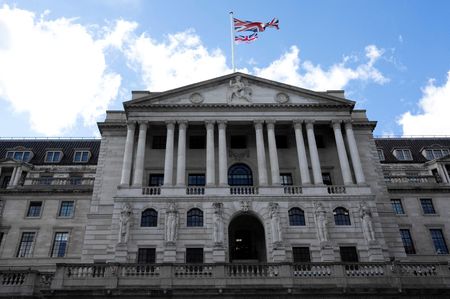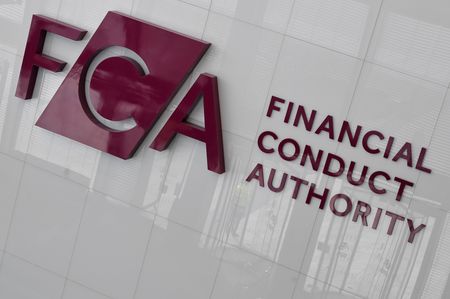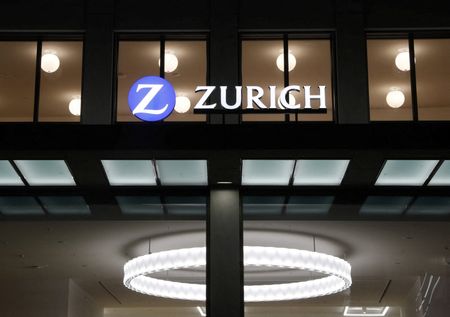By William Schomberg, David Milliken and Suban Abdulla
LONDON (Reuters) -The Bank of England cut interest rates on Thursday but four of its nine policymakers – worried about high inflation – sought to keep borrowing costs on hold, suggesting the BoE’s run of rate cuts might be nearing an end.
The contrasting views of the BoE’s top officials meant the Monetary Policy Committee held two votes for the first time since it was created in 1997 in order to reach a decision.
With the MPC facing the conflicting risks posed by an inflation rate that the BoE forecasts will soon be double its 2% target and a worsening of job losses, Governor Andrew Bailey and four colleagues backed lowering Bank Rate to 4% from 4.25%.
But that was only after a first round of voting ended in a 4-4-1 split, with external MPC member Alan Taylor initially backing a half-point cut.
“It remains important that we do not cut Bank Rate too quickly or by too much,” Bailey told a press conference after the decision, highlighting that the rise in inflation was expected to be short-lived.
“We stand ready to adjust our course if we see shifts in the balance of risk to the medium-term outlook for inflation.”
The four members of the MPC who backed keeping rates on hold included Clare Lombardelli, the deputy governor for monetary policy, who broke from the majority for the first time. Chief Economist Huw Pill also voted to keep Bank Rate at 4.25%.
British short-term government bond yields rose sharply and stocks fell after the announcement. Sterling jumped by about half a cent against the U.S. dollar.
Investors trimmed their bets on the possibility of another BoE rate cut by the end of 2025 and were only fully pricing in a cut to 3.75% in February next year, according to data from LSEG.
“The close vote split and the minutes of the meeting underscore the division on the MPC,” KPMG UK’s chief economist Yael Selfin said. “The division reflects the two-sided risks to the inflation outlook and the uncertainty under which policymakers are operating.”
Selfin said she expected one final BoE rate cut in November.
The central bank repeated its guidance about “a gradual and careful approach” to further cuts in borrowing costs but added a new line to its message on the outlook.
“The restrictiveness of monetary policy had fallen as Bank Rate had been reduced,” it said. It repeated that there was no pre-set path for borrowing costs.
A halt to the process of cutting rates would be a blow for finance minister Rachel Reeves and Prime Minister Keir Starmer, who have struggled to meet their promise to voters to speed up Britain’s slow economic growth.
Bailey said rates were still on a downward path but added there was “genuine uncertainty now about the course of that direction of rates … I think that the path has become more uncertain.”
James Smith, an economist with ING, said he still thought the next rate cut would come in November. “But were the next couple of inflation reports to surprise to the upside, or if the recent falls in private-sector employment start to ease off, then we’ll be rethinking,” he added.
CONFLICTING RISKS
The BoE is being pulled in different directions, leaving analysts as well as its own policymakers divided on its most likely moves in the coming months.
Britain’s jobs market has weakened in recent months, in part due to a tax hike by Reeves on employers and U.S. President Donald Trump’s trade war.
But inflation is rising. The BoE revised up its forecast for a peak in inflation to 4% in September from 3.7% and said it would remain alert to the risk that rising prices – especially for food – could push up wage deals and longer-term price pressures.
“Overall, the MPC judges that the upside risks around medium-term inflationary pressures have moved slightly higher since May,” the summary of the meeting said.
The BoE said it expected inflation to return to its 2% target only in the second quarter of 2027, three months later than its previous forecast.
By contrast, the European Central Bank expects inflation in the euro zone to hold below 2%. It has cut borrowing costs eight times since June of last year, three more reductions than those of the BoE.
Inflation has been above the BoE’s 2% target almost constantly since May 2021.
It said on Thursday that it expected economic growth of 0.3% in the July-to-September period, up from 0.1% in the second quarter. Longer-term growth forecasts were little changed from its report in May, with annual growth of just over 1% expected in the coming years.
(Writing by William Schomberg; Editing by Catherine Evans)










